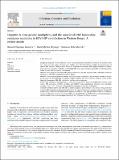| dc.description.abstract | ackground: Hepatitis B virus (HBV) and human immunodeficiency virus (HIV) co-infections are common as the
two viruses use same routes of transmission. Studies show that HIV infection modifies the natural course of
chronic HBV infection, leading to more severe and progressive liver disease, and a higher incidence of cirrhosis,
liver cancer and mortality. Therefore, determining HBV status and genotypes among HIV co-infected patients
would improve their therapeutic management.
Objective: This article reviewed the HBV genetic multiplicity and the associated HBV Lamivudine resistance
mutations in HBV/HIV co-infection in western Kenya.
Methods: Comprehensive literature searches and analysis were performed in peer-reviewed journals in the Na-
tional council for biotechnology information (NCBI), PubMed, and Web of science using key words of HIV,
Hepatitis B genotypes, HBV/HIV co-infection and Lamivudine resistance.
Results: HBV genotype A is predominant. D and E are also present in Kenya and neighboring countries in the
region. HBV polymerase rtV173L, rtL180M, and rtM204V major substitutional mutations were identified.
Currently, TDF + 3TC + DTG are recommended for treatment of HBV/HIV co-infection.
Conclusion: Evidence shows that HBV/HIV co-infection places a heavy burden to the society. Along with ART
regimen, HBV genotype is a major factor determining the course of disease and treatment outcome. Treating HIV
in HBV/HIV co-infection with antiretroviral agents may result in a very high prevalence of HBV 3TC-resistance
mutations. Therefore, improved screening for HBV and extended follow-up of HBV/HIV co-infected individuals is
needed to better understand the impact of different ART regimens on clinical outcomes | en_US |

